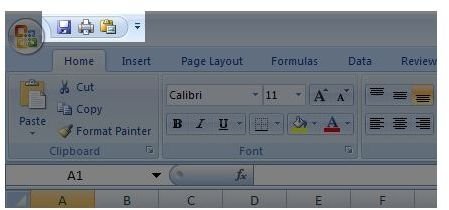Customizing the Buttons on the Excel 2007 Ribbon
Office 2007 was released in early 2007 with a new interface unlike any previous version of Microsoft Office. Part of Microsoft’s new Microsoft Office Fluent user interface, the Ribbon is an entirely new interface paradigm offering few options to customize the look and feel of the programs included in the Office software suite.
Excel 2007 is the popular spreadsheet application of the Microsoft Office suite. As with the other core applications such as Word 2007 and PowerPoint 2007, users can not easily add or remove buttons to the Ribbon to suite their individual needs. However, Microsoft did include a Quick Access Toolbar that is completely customizable much like the toolbars found in previous versions of Excel.
Microsoft Excel 2007 Ribbon and Quick Access Toolbar

The Microsoft Excel 2007 Ribbon
The Excel 2007 Ribbon is an interface tool specific to the spreadsheet application. Although the Ribbon is found in several of Microsoft’s other core Office 2007 products, the Ribbon found in Excel 2007 contains commands specific to a spreadsheet. For example, Excel lacks the “Reference” and “Mailings” tabs found in Word 2007. The tabs found in Excel 2007 include Home, Insert, Page Layout, Formulas, Data, Review, and Help (see Figure 1). The Ribbon changes depending on which tab the user has selected.
In a bold move, Microsoft made it difficult, although not entirely impossible, to change the Ribbon by adding or removing buttons as was possible in previous versions of Excel. In these previous versions, users could add and remove buttons to and from toolbars and even create completely new toolbars. Older versions of Excel also still use the older drop-down menu system of application navigation and customization. The result of the Ribbon is a technically cleaner interface but one that requires a higher learning curve for those users familiar with previous versions of the software.
Customizing the Quick Access Toolbar
The Ribbon may be largely uncustomizable but Microsoft did not completely remove any possibility of customizing Excel 2007’s interface. The Quick Access Toolbar (see Figure 2) can be customized much like the toolbars found in previous version of Excel.
To add a command button to the Quick Access Toolbar, right click on the toolbar and choose “Customize Quick Access Toolbar.” From there, a window opens allowing users to add and remove any number of popular commands found on the comprehensive Ribbon. For example, if you use the “Merge Cells” command often, you can add that command to the Quick Access Toolbar so you can merge cells without having to change tabs at the top of the Ribbon.
If you find that the commands you have placed on the Quick Access Toolbar are used more often than those on the Ribbon, you can permanently move the toolbar to a position below the Ribbon for faster access to those commands. To move the toolbar, right click on it and choose “Show Quick Access Toolbar Below the Ribbon.” Other than choosing to position the toolbar above or below the Ribbon, the Quick Access Toolbar does not have any other customizable options.
Adding Menus to the Excel 2007 Ribbon
Truthfully, adding and removing buttons on the Excel 2007 is not entirely impossible but to do so requires knowledge of a programming language called Extensible Markup Language (XML). XML is text-format, general-purpose markup language for creating structured computer documents. It is an open standard that can be used, for example, to redefine Hypertext Markup Language (HTML), the markup language of web pages. Rather than programming a new Ribbon menu, it may be easier to search the web for a solution that already exists.
Conclusion
The addition of Microsoft’s Office Fluent user interface includes the introduction of the Office 2007 Ribbon. Some people have argued that the inability to change the Ribbon is inconsistent with previous versions of Office where users could customize their interface to match their application needs. Save for one area, the Quick Access Toolbar, users of Excel 2007 and other Office applications are forced to hunt for common commands so easily found on the toolbars of past Microsoft Office applications. Although use of the Ribbon requires a steep learning curve for users of past versions of Excel, extended use of the Ribbon is often met with greater satisfaction as a move away from older drop-down menu systems and collections of disjointed toolbars.
